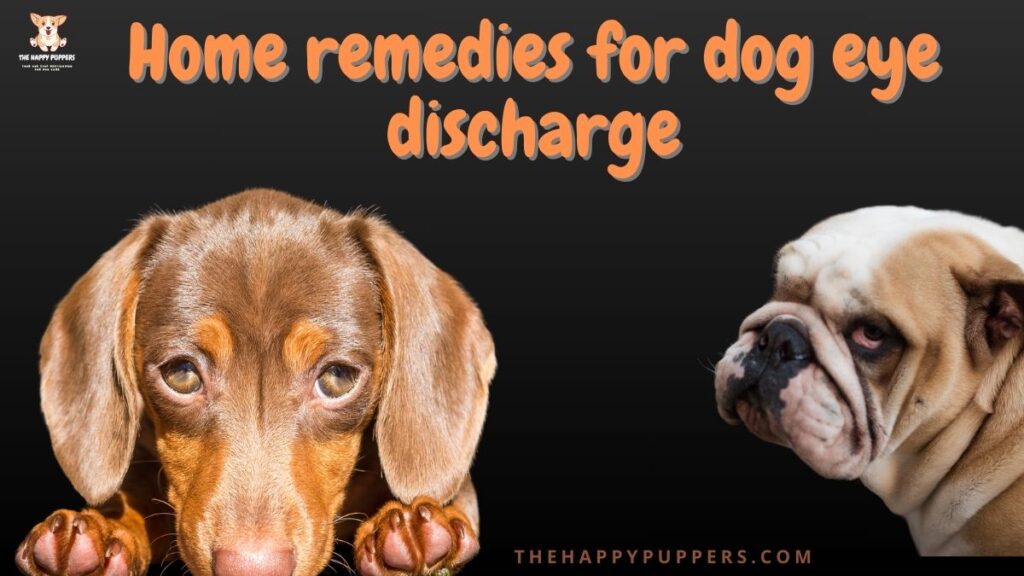The many signs of dog eye discharge, which can range from watery eyes to secretions that resemble mucus, are a major source of anxiety for pet owners. There are a number of potential causes for this problem, and dealing with each one requires careful consideration. Many things can go wrong with the eyes or tear production, such as infections, allergies, injuries, or underlying health issues. For efficient therapy and to guarantee the canine companion’s well-being, it is vital to identify the root cause. To keep dogs’ eyes healthy, it’s important to take them in for regular checkups at the vet, intervene quickly if necessary, and follow good eye care habits. In this light, it is essential for responsible pet management and the well-being of our canine companions to be aware of the most common reasons for ocular discharge in dogs.
If you wish to be the best dog guardian to your pup, subscribe to The Happy Puppers so you can stay up to date with all the latest tips and tricks from the dog care world. If you like watching videos, subscribe to the YouTube channel of The Happy Puppers, Shruti and Delta. Remember to ring the notification bell so that YouTube notifies you the moment the next video releases from the channel.
Topics covered in this blog post
Importance of addressing dog eye discharge promptly
For several reasons, the most important of which are related to the dog’s health, it is critical to treat ocular discharge in dogs as soon as possible:
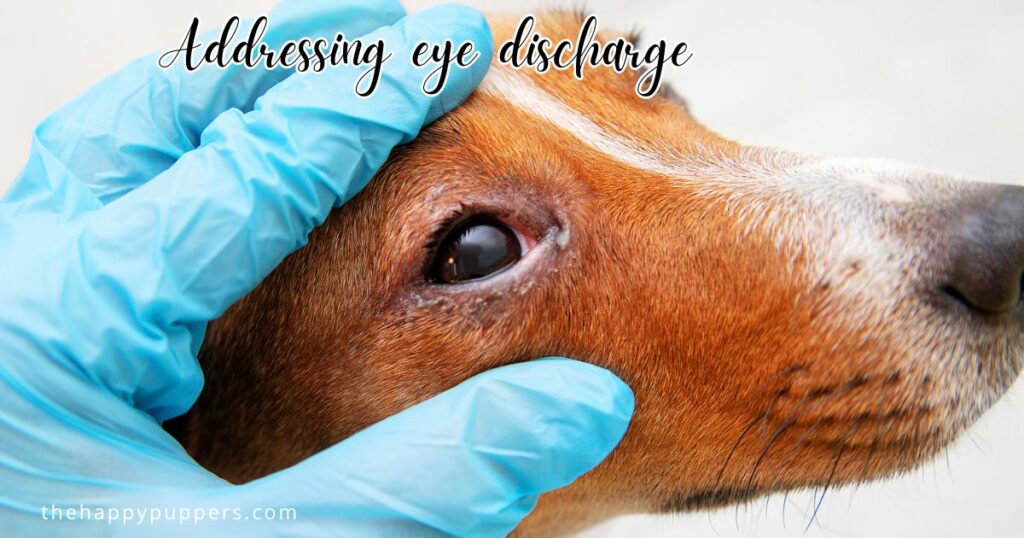
Medical reason
Primarily, there may be a medical reason for your eyes to be running. Prompt response to symptoms enables early identification and management of possible health issues. Delays in therapy can cause problems and protracted suffering for the dog, thus it’s important to intervene quickly in situations of inflammations, infections, or injuries.
Pain and discomfort
The dog may experience pain and discomfort due to the discharge from its eyes. They can be relieved of their agony and save needless suffering with prompt intervention. If pets with eye problems do not get treatment, their symptoms will worsen and their quality of life will suffer.
Irreversible vision loss
Also, irreversible vision loss can occur from several eye diseases if the disease is treated late. In order to avoid long-term effects and keep the dog’s eyes healthy, it is crucial to intervene quickly.
Could be transmissable and infectious
If you want to stop the transmission of infectious diseases, you have to deal with eye discharge right away. Treating infected dogs as soon as possible helps stop the spread of the disease to other pets and helps the afflicted dog recover faster from the infection.
Being responsible
Finally, taking care of eye discharge quickly isn’t just about helping the dog feel better right away; it’s also an important part of being a responsible pet owner. By catching problems early, treating them, and preventing further complications, you can help your dog stay healthy and happy.
A Guardian’s Guide to Dog Eye Discharge
Several conditions can impact a dog’s eye health, and discharge from the eyes is a common and noticeable indicator of these problems. The individual ailment determines the appearance of this discharge, which can take several forms such as watery, mucoid, or purulent discharges. The health of dogs depends on their owners being knowledgeable about the signs, symptoms, and possible causes of dog eye discharge.
Common causes behind dog eye discharge
Dogs might experience eye discharge for a variety of reasons. Infections, allergies, traumas, irregularities in anatomy, and systemic diseases are common reasons. Symptoms including eyes redness, swelling, and discharge can be caused by bacterial or viral diseases, like conjunctivitis. Watery eyes might be a sign of an allergy to pollen or a food intolerance. A variety of structural abnormalities, such as entropion or ectropion (eyelid abnormalities), can aggravate or even cause chronic eye problems, in addition to trauma or foreign objects, which can lead to discharge and discomfort.
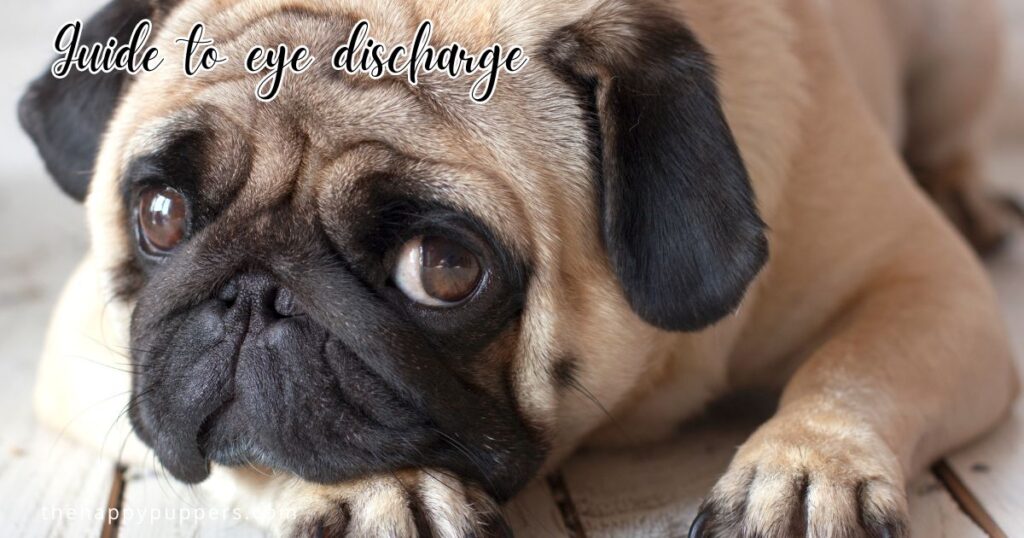
Signs and symptoms of dog eye discharge
Redness, squinting, excessive pawing, and behavioral abnormalities are additional symptoms that often accompany canine eye discharge. There can be further problems if your eyes get cloudy, if your eye color changes, or if your third eyelid (nictitating membrane) becomes apparent. The degree and possible reasons of the ocular discharge might be better understood by keeping an eye out for these indicators.
When You Should Take Your Dog to the Vet:
If the discharge from the eyes does not go away, is really bad, or is associated with other worrying symptoms, your pet needs to see a vet immediately. Finding the root problem and starting the right treatment are both aided by prompt intervention. Vision loss or chronic eye diseases are among the consequences that can result from inadequate or postponed treatment.
Diagnosis and Treatment:
In order to determine the source of the discharge, veterinarians may do a comprehensive examination, which may include eye examinations and, if needed, laboratory investigations. The underlying illness determines the treatment approach, which may involve antibiotics, anti-inflammatory drugs, or surgical procedures to correct structural defects.
Preventing dog eye discharge
The best way to keep your dog’s eyes from running is to practice good eye hygiene. Contributing to ocular health include regularly cleaning the region surrounding the eyes, avoiding irritants, and managing allergies or systemic health issues. Preventing and detecting eye-related issues early on is another important function of regular veterinarian check-ups.
Natural Treatments for Minor Dog Eye Discharge
When the discharge is mild and not associated with serious symptoms, easy home treatments can be used to treat it in dogs. These solutions can help alleviate your dog’s symptoms and promote good eye health.
Warm Saline Solution
If your dog is experiencing light eye discharge, one easy home remedy is to use a warm saline solution. To alleviate eye irritation and wash the eyes, use this procedure. Here is how you can easily make this solution:
- In a cup of hot distilled water, dissolve one teaspoon of salt.
- After mixing the saline solution well, let it cool to a comfortable temperature.
- Pick up any discharge around the eyes and gently wipe it away using a clean cotton swab or pad.
- Gently cleanse the area around your eyes by dipping a cotton ball into the saline solution.
- Use a new cotton swab for each eye and repeat as necessary.
Relieve Eye Irritation with a Chamomile Tea Compress
An effective home cure for minor ocular discharge is chamomile tea due to its calming and anti-inflammatory effects. Make and apply a chamomile tea compress as follows:*
- Infuse some hot water with chamomile flowers or a tea bag. Let it cool until it reaches room temperature.
- If you’re using loose chamomile flowers, you can filter the liquid to get rid of any particles.
- Apply chamomile tea using a clean cloth or cotton pad soaked in the tea.
- Gently lay the cloth or pad over closed eyes.
- Just give your dog a few minutes to unwind with the compress. Do it again as needed throughout the day.

Artificial Tears
Mild ocular discharge can be alleviated with the use of artificial tears made especially for dogs, which offer lubrication and moisture. To ensure a safe and successful application, please follow these steps:
- When shopping for a product, make sure to get dog-specific artificial tears. For appropriate recommendations, consult your vet.
- After reading the product instructions, put the specified amount of drops into each eye.
- To avoid contamination, make sure the dropper or bottle does not come into contact with the eye’s surface.
- Follow your vet’s or the product’s instructions for how often to apply artificial tears. Keeping your eyes well-lubricated is easy with regular use.
Note:
It is essential to contact with your veterinarian prior to starting any treatment, even though these home remedies are typically safe for minor instances. Veterinarian intervention is necessary to determine the source of the eye discharge and treat it if it continues, gets worse, or is associated with other worrying symptoms.
Natural Remedies and Supplements to help with dog eye discharge
Herbal supplements and solutions can be helpful in treating moderate eye discharge in dogs, in addition to home remedies. Promoting ocular health and alleviating discomfort, these natural choices utilize the power of herbs and important minerals.
Calendula Extract
To treat mild ocular discharge in dogs, you can use calendula, which is known for its antibacterial and anti-inflammatory effects. Here is
- If you want a solution made with calendula, you can either buy extract or dilute calendula tincture with purified water.
- Apply the calendula solution to the afflicted eye using a clean cotton ball or pad. Wash the discharge and any debris off gently.
- Use a new cotton swab for each eye and apply as necessary. Calendula’s calming effects can aid in the reduction of inflammation and the acceleration of the healing process.
Eyebright herb
You may help keep your eyes healthy with the help of the herb eyebright, scientifically known as Euphrasia officinalis. It has astringent and anti-inflammatory qualities. Here’s a way to give your dog some eyebright:
- To make a gentle eyebright tea, steep some dried eyebright herb in hot water. Let it cool down before you use it.
- Apply the cooled eyebright tea to your eyes using a clean, gentle cloth or cotton pad for a gentle eye wash. Remove discharge from the eye area by gently wiping it.
- Make sure the solution is gentle and won’t irritate the skin. Cut off use if it irritates the skin.
Omega-3 Fatty Acids
The omega-3 fatty acids in fish oil can aid with moderate eye problems and general eye health. A few ways to include omega-3 supplements into your routine:
- Discuss the recommended dosage of omega-3 supplements with your vet based on your dog’s breed and size.
- Add the specified quantity of fish oil to your dog’s regular meal. Another option is to get your pet some omega-3 pills specifically designed for them.
- Taking omega-3 fatty acid supplements on a regular basis will help maintain a healthy tear film and potentially lessen inflammation in the eyes.
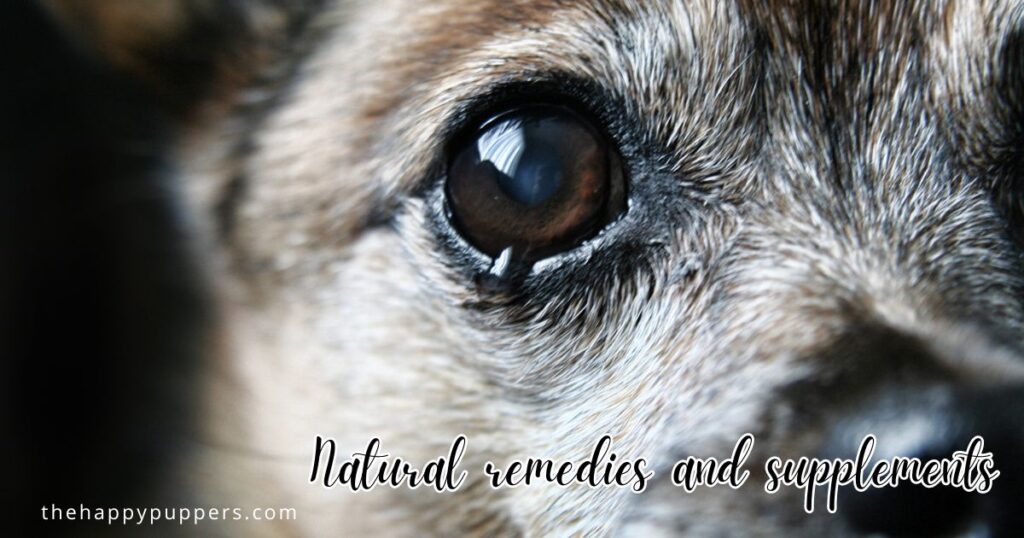
Note
Before adding any new herbs or supplements to your dog’s regimen, it is vital to contact with your veterinarian. Herbal treatments and supplements can offer natural support. It is important to get medical advice to ensure you are taking the medication correctly and to address any concerns you may have about drug interactions. See your vet right away for a thorough examination and treatment if the eye discharge continues or gets worse.
Improving Eye Health via Modifying The Diet
To keep dogs healthy all over, including their eyes, it is essential to feed them a balanced and nutritious diet. Modifying one’s diet can help with minor ocular discharge prevention and treatment. When planning your dog’s diet to support good eye health, keep these things in mind.
Why a Well-Rounded Diet is Crucial
To keep your eyes healthy, it’s vital to eat a diet rich in certain nutrients. Maintaining good health and warding off dietary deficiencies—which can exacerbate eye problems—is easier with a well-rounded diet. To put nutrient-dense foods first, consider the following:
- Your dog needs a balanced meal that provides all the nutrients they need, so make sure it’s complete and balanced.
- Essential vitamins and minerals can be provided by a balanced homemade diet or high-quality commercial dog food.
- Include vitamin A-rich foods in your dpg’s diet, like carrots, sweet potatoes, and liver.
- To prevent and maintain healthy eyes, including night blindness, vitamin A is a crucial component.
- Include fish or fish oil supplements, which are good providers of omega-3 fatty acids, in your dog’s diet. Omega-3 fatty acids are good for the eyes and could even help lower inflammation.
Supporting Eye Function with Antioxidant-Rich Foods
In order to keep the eyes healthy and functioning properly, antioxidants are essential. You should feed your dog meals that are rich in antioxidants:*
- Because of their high antioxidant content, blueberries can help keep your dog’s eyes healthy. Their anthocyanin content suggests they could have anti-inflammatory properties.
- The antioxidants lutein and zeaxanthin, which are present in spinach, are good for your eyes. Add it moderately to your dog’s food.
- The immune system and eye health are both aided by the antioxidants and vitamin C found in broccoli.
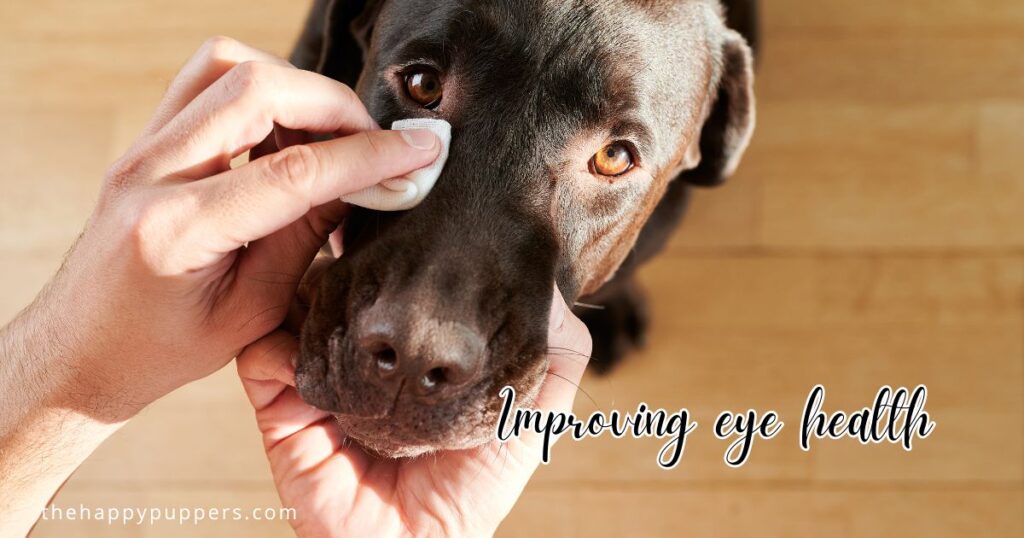
Hydration: Maintaining an Appropriate Humidity Level
Ensuring that your dog’s eyes stay properly hydrated is absolutely crucial. Dried eyes and pain are symptoms of dehydration. Follow these steps to stay properly hydrated:
- Make sure that everyone has constant access to safe drinking water. For optimal health, including proper eye lubrication, it is essential to stay hydrated.
- If your dog has a habit of not drinking enough water, it is important to supplement their diet with moist or wet dog food. Hydration levels can be influenced by foods that are wet.
- Keep an eye out for symptoms of dehydration in your dog, such as drowsiness and watery eyes, and be sure to keep a watch on his water consumption.
NOTE
Before making any major modifications to your dog’s food, you should consult with your veterinarian. Given your dog’s age, breed, and current health condition, they will be able to advise you on his or her individual dietary requirements.
Preventing Dog Eye Discharge

Proactive measures to preserve ocular health and detect possible problems early on are necessary to prevent eye discharge in dogs. You can help keep your dog’s eyes healthy by taking preventative actions. Here are important things to keep in mind:
Consistent Eye Care
If you want to keep your eyes healthy and free of infections, it’s important to clean around the eyes on a regular basis. For proper eye care, follow these steps:*
- Using a moist, clean cloth or pet wipes, delicately remove any discharge or debris from your dog’s eye corners.
- When cleaning, use gentle, pet-safe products or saline solutions to avoid harming your pet. Keep your eyes safe from potentially irritating chemicals and other contaminants.
- Make washing your dog’s eyes part of your overall self-care program. This lessens the likelihood of eye-related problems caused by dirt buildup.
Tips for Outdoor Activities
Dogs may be exposed to ocular irritants when engaging in outdoor activities. During these activities, it is important to take steps to protect their eyes:
- When engaging in activities like hiking or playing in the sand that could expose you to debris or UV rays, it’s a good idea to use protective eyewear, such as doggy goggles.
- Debris entering the eyes is more likely in windy environments. Stay indoors or under cover when the weather turns windy.
- Remember to give your dog a gentle rinse with clean water after playing outside. This will help remove dirt and grime from their face and eyes. By doing so, you can keep your eyes clean and protected from possible irritants.
Watching for Alterations in Conduct
You can catch early warning symptoms of eye problems in your dog by keeping a close check on his behavior and general health. Be on the lookout for any changes or new symptoms:
- Keep an eye out for indications of pain, excessive blinking, or rubbing the eyes. It could be a sign of eye pain if you’re acting strangely.
- If you observe redness, swelling, or chronic squinting around the eyes, it is important to seek a comprehensive checkup from your veterinarian.
- Tearing is usual to a certain extent, but excessive ripping could indicate a problem. If you notice any major changes, it’s best to consult a veterinarian.
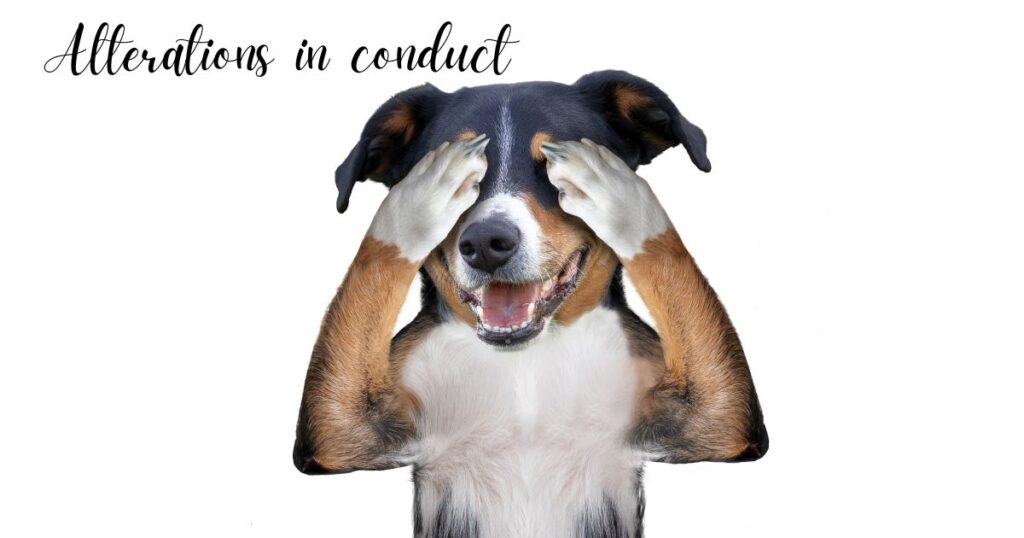
Note:
See your vet right away if your dog shows symptoms of pain or discomfort, or if you find excessive or continuous discharge from his eyes. Preventative care and early diagnosis of potential eye disorders are greatly enhanced by regular veterinary check-ups.
You can help keep your dog’s eyes healthy and free of discharge by practicing good eye hygiene, keeping them covered when playing outside, and keeping an eye out for any changes in their behavior.
When Should You Take Your Dog to the Vet for Dog Eye Discharge?
In moderate cases, home remedies and preventive measures can help with ocular discharge in dogs. However, there are times when it’s absolutely necessary to see a veterinarian. The health and happiness of your dog depends on your ability to recognize when it’s time to take it to the vet.
Over-the-Counter Solutions Aren’t Working
Some symptoms point to a more serious problem than what a do-it-yourself solution can solve. It may be necessary to consult a veterinarian when:
- If the discharge from the eyes does not go away after you try home remedies, it could be a sign of something more serious that needs medical intervention.
- Consult your vet without delay in the event of any changes in the outward look of the eyes. This includes but is not limited to cloudiness, changes in color, or noticeable abnormalities.
- Your canine needs to see a vet right away if he or she shows signs of eye pain, including rubbing, excessive squinting, or avoiding light.
Expert’s Opinion and Care for Dog Eye Discharge
Accurately diagnosing the source of ocular discharge and administering proper treatment requires veterinary knowledge. Get help from a doctor or emergency vet nurse when:
- A veterinarian can detect the source and recommend particular drugs or treatments for severe cases of inflammation, infection, or discharge from the eyes by doing a thorough examination of the eyes.
- If a veterinarian suspects a structural abnormality, like entropion or ectropion, they can evaluate the situation and suggest surgical procedures if needed.
- The veterinarian can do tests to identify the particular pathogen and administer medications that are specifically designed to treat the infectious disease if it is suspected that it is the cause of the ocular discharge.
Veterinary Consultation and Home Care for Dog Eye Discharge
To ensure complete eye health, it is essential to work together with veterinary guidance and home care practices. Be sure to keep the lines of communication open with your vet:
- Make sure your dog’s eyes are healthy by taking him in for checkups at the vet on a regular basis.
- More effective interventions can be achieved through early detection of possible concerns.
- It is imperative that you strictly adhere to your veterinarian’s prescribed treatments and other advice.
- Medication, follow-up consultations, or more testing may be part of the vet’s examination procedure.
- Share with your vet any changes you’ve made to your pet’s routine or new treatments.
- The availability of home data can help the vet better diagnose your dog’s condition and treat his eyes in a unified fashion.
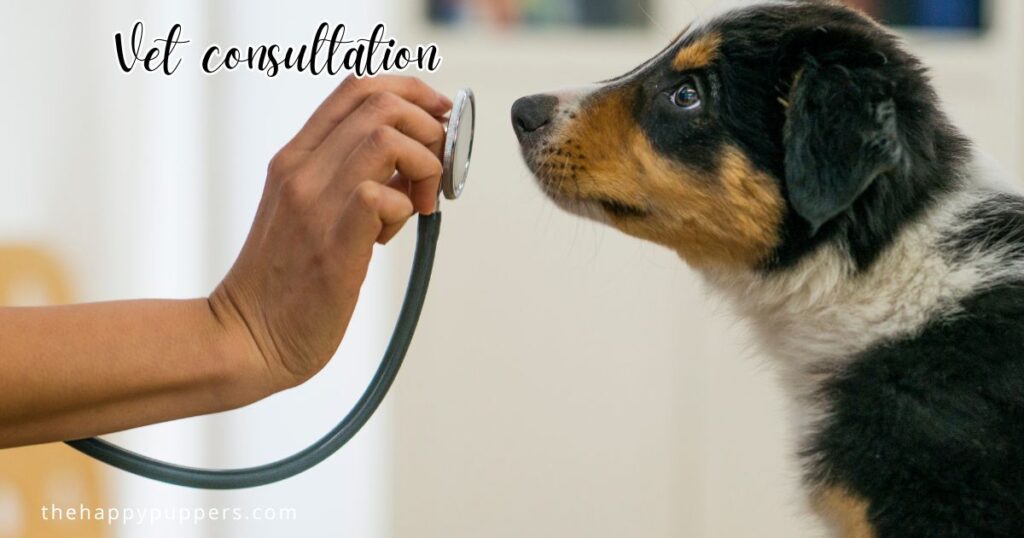
Conclusion
Dog eye discharge is not that unheard of amongst the vet clinics and dog guardians. There are many moving parts to the complex task of ensuring our canine friends’ eye health, which requires both preventative measures and regular, at-home care as well as prompt veterinary attention when necessary. Simple cases of eye discharge can be treated at home with warm saline solutions, herbal extracts, and dietary changes. Nevertheless, it is essential to be aware of the symptoms that may suggest a visit to a veterinarian, such as severe or chronic illnesses, changes in the way the eyes seem, or indications of pain or discomfort.
It is fundamental to maintain proper eye care, use protective eyewear when engaging in outdoor activities, and eat a healthy, well-balanced diet that is rich in nutrients. These safety precautions can lessen the likelihood of eye problems. Another important part of proactive care is keeping a close eye on your dog’s behavior and acting quickly if you notice any changes or unexpected symptoms.
Our canine companions’ health, happiness, and longevity are enhanced when we pay close attention to their needs, include preventative measures in their regular care, and take them to the vet when needed. Our beloved canine friends can enjoy ideal eye health for the rest of their lives with the help of a proactive and cooperative approach.
If you wish to be the best guardian for your dog, subscribe to The Happy Puppers so you can stay updated with the latest tips and tricks about dog care, psychology and training. If you like watching videos, subscribe to the YouTube channel of The Happy Puppers, Shruti and Delta. Remember to ring the notification bell and set it to ALL so YouTube never misses out on notifying you about the latest videos released from the channel.
See you in my next blog pot
Frequently Asked Questions
If your dog has eye discharge, try using a saline solution or fake tears to clean his eyes gently. Get the lowdown on how often and how precisely to apply these medicines before using.
Some of the many causes of discharge from a dog’s eyes include allergies, infections, foreign objects, or even serious health problems. In order to get the best home treatment, it is crucial to understand the exact problem.
An effective and mild solution for cleaning your dog’s eyes can be prepared by dissolving one teaspoon of salt in one cup of warm water. To remove any discharge, begin at the inside corner and work your way outward using a clean cloth or cotton ball.
Yes, chamomile tea bags can be beneficial. After steeping a chamomile tea bag in hot water, allow it to cool. Gently press the cooled tea bag against your dog’s closed eyes for a few minutes. Chamomile’s soothing properties may help reduce inflammation and irritation.
It is important to get the advice of your veterinarian before using coconut oil to your dog’s eyes, despite the fact that it contains inherent antimicrobial and anti-inflammatory qualities. For added moisture and comfort, try dabbing some cooled coconut oil over your eyes if it’s okay with your doctor.

